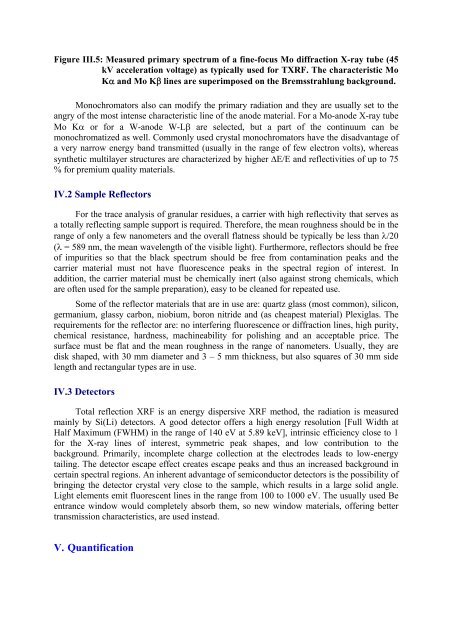X-Ray Fluorescence Analytical Techniques - CNSTN : Centre ...
X-Ray Fluorescence Analytical Techniques - CNSTN : Centre ...
X-Ray Fluorescence Analytical Techniques - CNSTN : Centre ...
Create successful ePaper yourself
Turn your PDF publications into a flip-book with our unique Google optimized e-Paper software.
Figure III.5: Measured primary spectrum of a fine-focus Mo diffraction X-ray tube (45<br />
kV acceleration voltage) as typically used for TXRF. The characteristic Mo<br />
Kα and Mo Kβ lines are superimposed on the Bremsstrahlung background.<br />
Monochromators also can modify the primary radiation and they are usually set to the<br />
angry of the most intense characteristic line of the anode material. For a Mo-anode X-ray tube<br />
Mo Kα or for a W-anode W-Lβ are selected, but a part of the continuum can be<br />
monochromatized as well. Commonly used crystal monochromators have the disadvantage of<br />
a very narrow energy band transmitted (usually in the range of few electron volts), whereas<br />
synthetic multilayer structures are characterized by higher ∆E/E and reflectivities of up to 75<br />
% for premium quality materials.<br />
IV.2 Sample Reflectors<br />
For the trace analysis of granular residues, a carrier with high reflectivity that serves as<br />
a totally reflecting sample support is required. Therefore, the mean roughness should be in the<br />
range of only a few nanometers and the overall flatness should be typically be less than λ/20<br />
(λ = 589 nm, the mean wavelength of the visible light). Furthermore, reflectors should be free<br />
of impurities so that the black spectrum should be free from contamination peaks and the<br />
carrier material must not have fluorescence peaks in the spectral region of interest. In<br />
addition, the carrier material must be chemically inert (also against strong chemicals, which<br />
are often used for the sample preparation), easy to be cleaned for repeated use.<br />
Some of the reflector materials that are in use are: quartz glass (most common), silicon,<br />
germanium, glassy carbon, niobium, boron nitride and (as cheapest material) Plexiglas. The<br />
requirements for the reflector are: no interfering fluorescence or diffraction lines, high purity,<br />
chemical resistance, hardness, machineability for polishing and an acceptable price. The<br />
surface must be flat and the mean roughness in the range of nanometers. Usually, they are<br />
disk shaped, with 30 mm diameter and 3 – 5 mm thickness, but also squares of 30 mm side<br />
length and rectangular types are in use.<br />
IV.3 Detectors<br />
Total reflection XRF is an energy dispersive XRF method, the radiation is measured<br />
mainly by Si(Li) detectors. A good detector offers a high energy resolution [Full Width at<br />
Half Maximum (FWHM) in the range of 140 eV at 5.89 keV], intrinsic efficiency close to 1<br />
for the X-ray lines of interest, symmetric peak shapes, and low contribution to the<br />
background. Primarily, incomplete charge collection at the electrodes leads to low-energy<br />
tailing. The detector escape effect creates escape peaks and thus an increased background in<br />
certain spectral regions. An inherent advantage of semiconductor detectors is the possibility of<br />
bringing the detector crystal very close to the sample, which results in a large solid angle.<br />
Light elements emit fluorescent lines in the range from 100 to 1000 eV. The usually used Be<br />
entrance window would completely absorb them, so new window materials, offering better<br />
transmission characteristics, are used instead.<br />
V. Quantification


